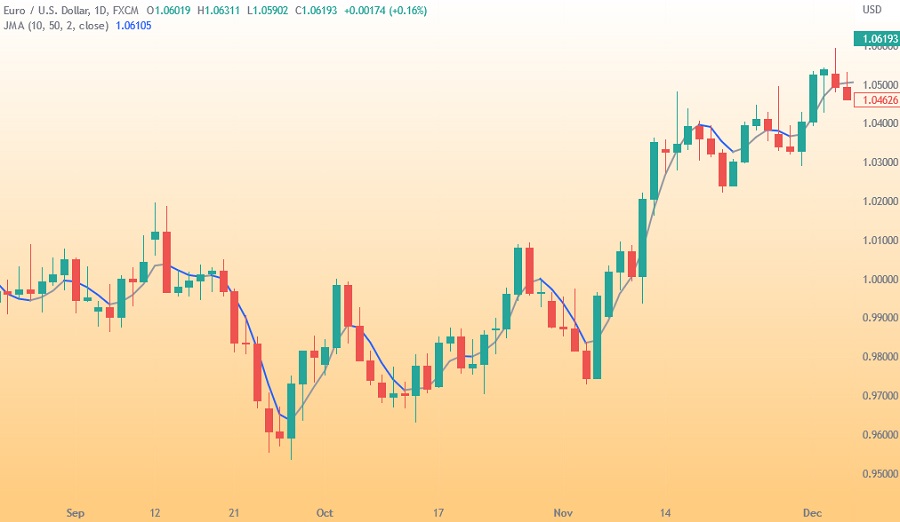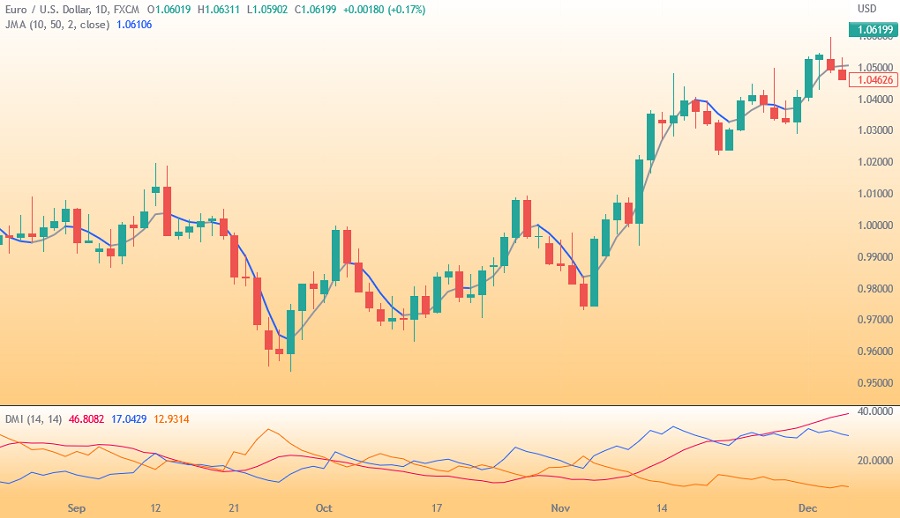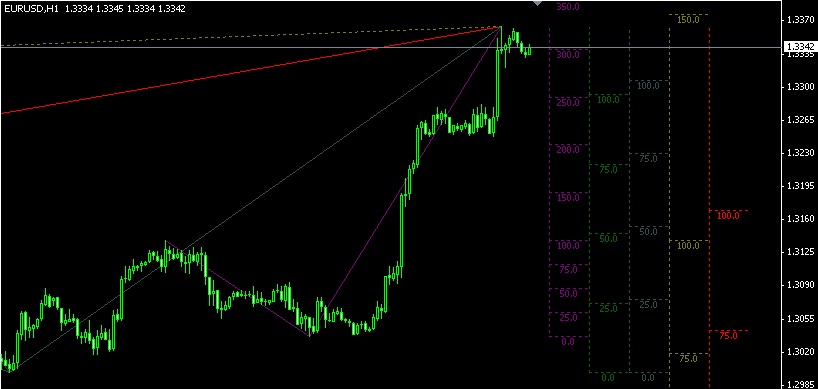Jurik Moving Average is not just another type of MA as it is specifically created by an expert as a non-repainting indicator that is more responsive to price trends.
Sometimes when using technical tools and indicators in your trading, you will notice that the tools seem to be lagging or they aren't performing as accurately as they're supposed to be. You may notice that the market is moving forward, but the moving average tool is still lagging behind and struggling to keep up with the current market values. This is where the Jurik Moving Average comes in.
Contents
Jurik Moving Average in a Nutshell
The Jurik Moving Average (JMA) is a technical indicator that is used with other indicators to predict the price direction in forex charts. This indicator was developed by Mark Jurik and is a type of weighted moving average indicator that gives more weight to recent market data rather than past historical data. As such, Jurik Moving Average can be used to identify trends more easily.
The way it works is that the indicator will smooth out price data which will make it easier to read. It can also be used as part of a trading system to generate buy and sell signals more easily by identifying the current and future market trends and patterns. While there are different ways to calculate JMA, the most common one uses the weighted factor.

The theory behind the Jurik Moving Average consists of two parts. The first part takes into account price gaps. The JMA will smooth out the time series data which will eventually produce a graph that is easy to read and understand. The thing that makes this indicator stand out when it comes to price gaps is that it doesn't produce any lag as compared to other technical tools.
The other part of this theory takes into account the noise reduction filter. It was found that the JMA reads the information in a unique way by adapting a non-linear filtering mechanism. The result of this mechanism is the non-lagging and accurate qualities. It even takes into account overshoots and undershoots in the price gaps.
Types of Jurik Moving Averages
- Standard JMA
The standard JMA is the most basic form of this moving average. The way it is calculated is by taking the sum of all the prices over a certain period of time and dividing it by the number of periods in that time frame. - Adaptive JMA
The adaptive JMA is the most sophisticated form of this moving average. The way it works is that it automatically adapts to the current market conditions by adjusting its parameters every time the market conditions change. - Weighted JMA
The weighted JMA is the most popular form. It is actually very similar to the standard JMA. The only difference is that it places more importance on current market data rather than historical market prices. - Exponential JMA
The exponential JMA is even more sophisticated than the adaptive JMA and is quite similar to the weighted JMA. The way it works is that it places more weight or importance on current market data. It does so using an exponential function, hence the name.
Jurik Moving Average Phase Parameter
This parameter helps to adjust noise in a time series. You can do so by increasing and decreasing the length of the parameter. For instance, increasing the length of the parameter will make the JMA moves slower. While this will reduce noise, it will also increase lag in the moving average. However, you can also adjust the inertia within the JMA. If the JMA has a ton of inertia, it will reduce noise but it will still overshoot during reversals. These are just some of the parameters you need to look out for.
See Also:
Jurik Moving Average Data Changes
One of the worst things to find out is that your indicator is repainting. What this means is that it changes its previous values upon the arrival of new market data. This can make the indicator looks very accurate, but in reality, it is not reliable at all. Fortunately, JMA is not a repainting indicator, so it does not change its values upon the arrival of new data. This indicator only uses current and past market data when predicting trends and not future market data.
Jurik with Other Indicators
The Jurik Moving Average is a reliable technical tool for forex trading. However, it isn't the only tool in the industry that is worth trying. As a result, it is always best to use another reliable tool along with the JMA to increase your chances of success and profitable trades. For instance, you can combine JMA and the DMI indicator.

Another recommended tool is the Kalman filter. Both Kalman and Jurik Moving Average are powerful tools that use algorithms to estimate the noise of a forex chart. They smooth out the data in a time series to make it easier to understand. They also help with lag, overshooting, and undershooting.
Final Verdict
There are several reasons why the JMA is a popular tool among advanced forex traders. This tool is able to respond to price swings more quickly than most other tools in the market. It also has almost no overshoot, and it glides through small market movements with ease. It does not let small activity impact the overall result of the algorithm.
However, this indicator is comparatively more difficult to understand than other tools in the market. It is best to first test it out in a demo account before making use of it in your real trading account. This way, you will only be using it when you're absolutely ready to do so.

 Dedicated FREE FOREX VPS
Dedicated FREE FOREX VPS Free FOREX Virtual Private Server
Free FOREX Virtual Private Server MT4 Demo Contest, Get $500
MT4 Demo Contest, Get $500 Sign Up for an Account, Claim 60% Deposit Bonus
Sign Up for an Account, Claim 60% Deposit Bonus Free MT4/MT5 VPS 2024
Free MT4/MT5 VPS 2024 Send E-mail and Get Free Merchandise
Send E-mail and Get Free Merchandise $1K Refer a Friend Bonus for Pepperstone Pro clients
$1K Refer a Friend Bonus for Pepperstone Pro clients Maximize Your Earnings with 100% Deposit bonus
Maximize Your Earnings with 100% Deposit bonus Trade to Win, $5,000 Monthly Demo Contest
Trade to Win, $5,000 Monthly Demo Contest Claim 30% + 15% Deposit Bonus from LiteFinance
Claim 30% + 15% Deposit Bonus from LiteFinance













2 Comments
Ronaldo
Jan 30 2024
Hello, the article mentions that The Jurik Moving Average (JMA) functions as a technical indicator in forex charts, collaborating with other indicators to forecast price movements. Created by Mark Jurik, it belongs to the category of weighted moving averages, prioritizing recent market data over historical information. Consequently, the Jurik Moving Average facilitates the identification of trends.
I'm curious about the distinction between JMA and EMA. Are both of these indicators considered weighted moving averages? And could you explain the concept of Weighted Moving Average?
Ramos
Feb 2 2024
Certainly! Yes, both JMA (Jurik Moving Average) and EMA (Exponential Moving Average) are types of weighted moving averages.
Weighted Moving Average (WMA) is a concept where different weights are assigned to various data points in a time series. In the context of moving averages like JMA and EMA, more emphasis is given to recent data points, making them more responsive to current market conditions. This weighting helps in providing a smoother representation of trends by reducing the impact of older data. About WMA and the other moving average, you can just read this article : What are the Four Major Moving Averages?
In summary, both JMA and EMA are weighted moving averages, utilizing different weighting schemes, but sharing the common characteristic of placing greater importance on recent market data.